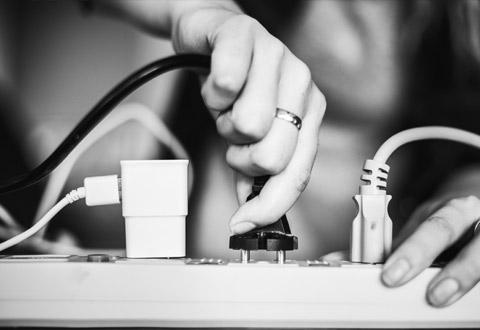
When confronted with an electrical fire in your home most homeowners are caught off-guard. You believe it came out of nowhere and that there were no signs. Sadly, there probably were signs, you just may be unaware of what they are. In part two of our series on electrical safety at home, we will look at your circuit breaker box or electrical panel, the circuit breakers and electrical outlets.
The location of the circuit breaker box or electrical panel is generally found in the basement of homes, however, it may also be located in the garage, hallway or a storage/ utility room. This gray box contains circuit breakers which are electrical switches designed to protect an electrical circuit from damage caused by overcurrent, typically resulting from an overload or short circuit. Its basic function is to interrupt current flow after a fault is detected.
When a circuit breaker trips it is normally indicating that there is a problem, but often the homeowner will just go to the panel and flip the switch because you can’t visually see a problem. Sometimes this is okay, but if the breaker trips again after being reset the likelihood that there is an electrical problem has increased significantly. So here are a few tips to help keep you and your home safe:
Listen to your breaker
A breaker that trips immediately after it's reset is telling you that there's an electrical problem. Sure, sometimes the breaker itself is to blame, and in some cases, there may just be too large an electrical load operating on that circuit. But it's more likely that the breaker is tripping because there's a severe electrical problem. Keep pressing that breaker, and you're likely to cause a fire. So, the best advice in this situation is to call an electrician and let them know you are having a problem.
Know your outlets
When you look at a normal 120-volt outlet, there are two vertical slots and then a round hole centered below them. The left slot is slightly larger than the right. The left slot is called "neutral," the right slot is called "hot" and the hole below them is called "ground." If an appliance is working properly, all electricity that the appliance uses will flow from hot to neutral.
Then there is the Ground Fault Circuit Interrupter (GFCI) – This is a type of outlet which constantly monitors electricity flowing in a circuit, to sense any loss of current, and is a safeguard to prevent people from electrical shock.
A GFCI monitors the amount of current flowing from hot to neutral. If there is an imbalance, it trips the circuit immediately. This prevents you from a potentially fatal accident and it also prevents your home from any electrical hazards that would likely result in fire. It is very common to find GFCI outlets in kitchens, bathrooms, garages, unfinished basements, and anyplace within 6 feet of water.
